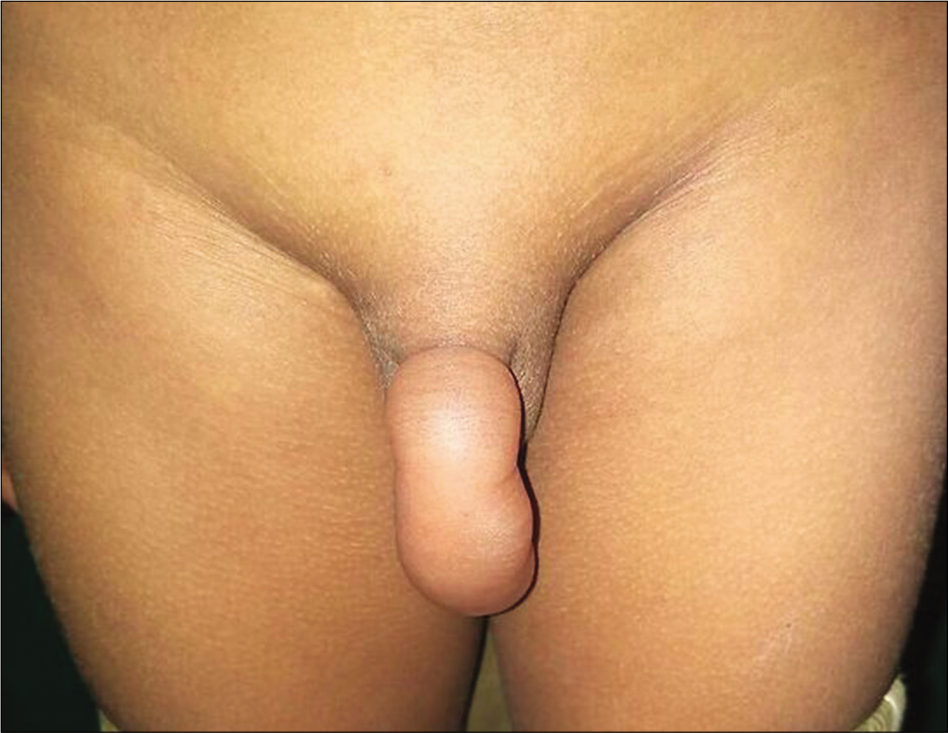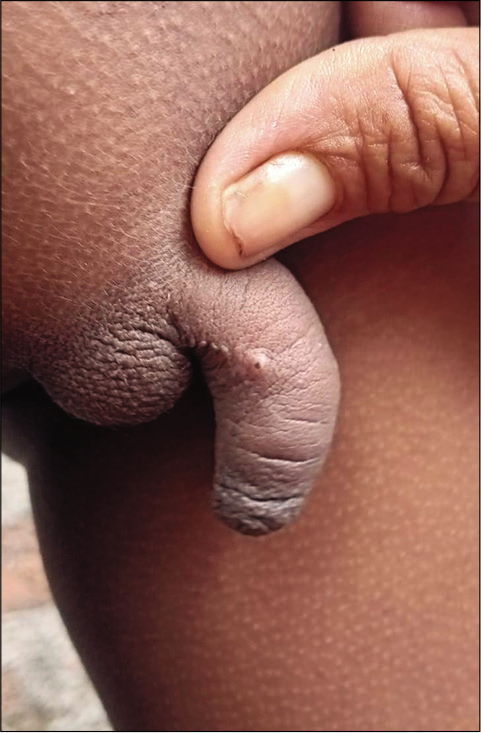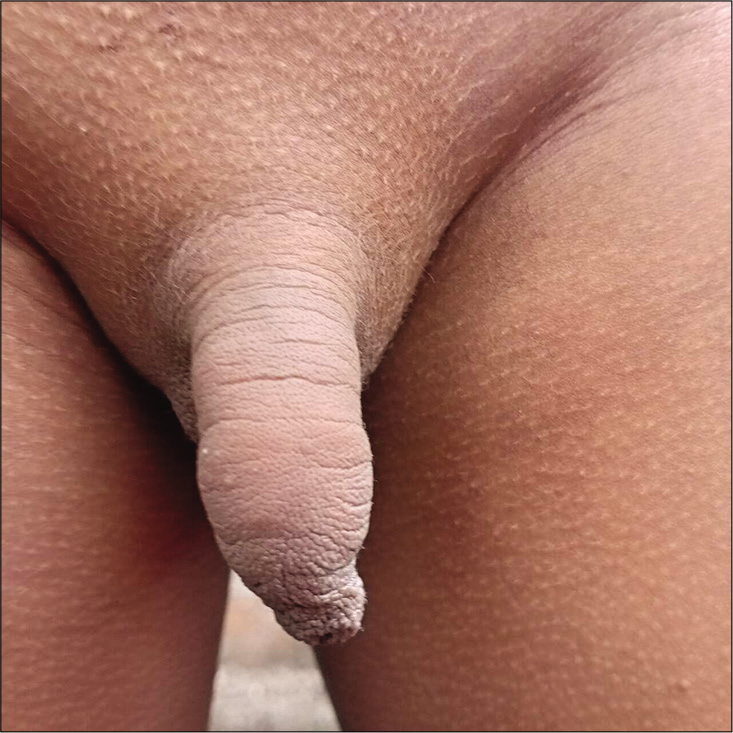Translate this page into:
Penile angioedema in a child: A nightmare to parents!
*Corresponding author: K. S. Lakshmi Srividya, Department of Dermatology, Venereology, Leprosy, Kamineni Institute of Medical Sciences, Hyderabad, Telangana, India. srividya.siri95@gmail.com
-
Received: ,
Accepted: ,
How to cite this article: Srividya KS, Vidyasagar P. Penile angioedema in a child: A nightmare to parents! Indian J Skin Allergy 2022;1:21-3.
Abstract
Angioedema is a transient, non-pitting oedema that involves subcutaneous or submucosal tissue. Angioedema in children can have varied aetiology and clinical manifestations, unlike that in adults. We report a case of angioedema of penis in a child resulting from insect bite and treated successfully with anti-histamine and leukotriene inhibitor. Penile angioedema should be kept in mind as a differential diagnosis of penile swelling, as early diagnosis and management may prevent fatal complications.
Keywords
Angioedema
Paediatric
Penile
Insect bite
INTRODUCTION
Angioedema is a transient, episodic, non-pruritic, non-pitting edema that involves subcutaneous or submucosal tissue. Angioedema in children can have varied etiology and clinical manifestations, unlike that in adults. Pediatric angioedema can be due to many causes such as allergy to topical or systemic medications, insect bites, and hereditary angioedema. Here, we describe a case of angioedema of the penis in a 6-year-old child resulting from an insect bite in the affected region.
CASE REPORT
A 6-year-old child is brought to our hospital with complaints of sudden onset of swelling over penis since 1 day. It was associated with pain during micturition and pain while walking. There was a history of unknown insect bite the previous night following which the child developed swelling of the penis by the following morning. There was no similar history of penile swelling in the past. He had no history of trauma, blood transfusion, or use of any medication. There was no history of associated skin rash, abdominal pain, dysphagia, stridor, dyspnoea, urethral discharge, sore on the penis, or lower urinary tract symptoms. There was no history of sexual abuse in the child. There was no history of similar complaints in the family.
Physical examination revealed diffuse soft non-pitting edema of the entire penile shaft [Figure 1]. There was mild erythema and tenderness. There was an inability to retract the prepuce. There was no local rise of temperature. A skin-colored papule with an overlying crust was seen on the penis indicating the site of insect bite [Figure 2]. The urinary stream was normal. The scrotum was normal. There was no regional lymphadenopathy. His vitals were stable. His pulses were of normal volume, respiratory rate was 18 cycles/min, heart rate was 88 beats/min and blood pressure was 90/60 mm Hg. Systemic examination was normal. Routine investigations including urinalysis and complete blood count were done and within normal limits.

- Edema of the entire penile shaft.

- Papule noted on penis indicating insect bite.
A diagnosis of angioedema secondary to insect bite was made. The child was treated with antihistamine and leukotriene inhibitor combination, Tablet Levocetirizine 2.5 mg + Montelukast 4 mg once daily at bedtime for 1 week. Edema resolved within 1 week without any sequelae [Figure 3]. There were no new episodes in follow-up.

- Edema resolved without any sequelae.
DISCUSSION
Angioedema and urticaria are the different manifestations of a same pathological process.
Angioedema is due to extravasated fluid in the deeper subcutaneous and submucosal tissues.[1,2] The lesions are of sudden onset and last for hours to few days, unlike urticaria that resolves within hours.[3] The incidence of angioedema is same in both males and females.[4] The causes of angioedema include food allergies, insect bites, infections, drug allergies, and idiopathic. Genital angioedema can be triggered by additional causes such as trauma to the perineum or sexual intercourse.[5]
Our patient in this report had a history of unknown insect bite. Reactions that follow insect bite include erythema, pain, itching, edema that are limited to the area of bite. Systemic reactions to insect bites are less common, but they can be life-threatening.[6]
Insect bites to the penis are under-reported as it may be a cause of embarrassment.
Very few case reports of penile angioedema following bumblebee bite,[7] centipede bite,[3] wasp stings[8] or unknown insect bites[9] were reported in the literature.
Summer penile syndrome is caused by chigger bites on the penis, which is characterized by erythema, edema, and pruritus on the penis. This is a fairly common cause of insect bite associated penile angioedema in the pediatric age group in Western countries.[10,11]
Penile angioedema in child can be a diagnostic dilemma as it is very rare and insect bite reaction should be kept in mind. The possible causes should be kept in mind for appropriate management.
The history of staying outdoors, especially rural and wooded lands before the onset of symptoms can lead to the possibility of insect bites and stings. Children are often brought with a history of playing in the gardens and fields before the onset of penile swelling. The presence of similar complaints or bite marks in others accompanying the person can also be considered as a diagnostic clue. Insect bites should be kept in mind in these scenarios when there are no bite marks or skin lesions. Insect bites on the adjacent areas or elsewhere on the body can also be a diagnostic clue.[12]
Clinically, the presence of erythema and tenderness indicates inflammatory condition. Swelling of adjacent areas of limbs, lower abdomen, and scrotum, presence of priapism can indicate underlying penile venous thrombosis. Contact dermatitis should have a history of contact with offending agent, burning sensation, and swelling confined to the areas of contact. Localized congenital or acquired lymphedema of the penis and scrotum is a possibility to be considered. The overlying skin is thickened, dry, and hardened. Sexually transmitted infections should be kept in mind as a differential diagnosis in any case of genital swelling. History of sexual exposure, presence of other skin or genital lesions indicates the possibility of sexually transmitted infection. Necrotizing perineal infection including Fournier gangrene can cause extensive swelling, but it is associated with severe inflammation and necrosis. Crohn’s disease has other associated symptoms and it does not respond to routine antihistamine therapy.[13]
Biopsy is not routinely indicated, except in cases of doubtful etiology, or when no bite marks or lesions can be seen on the penis. Biopsy is done to rule out extra-intestinal Crohn’s disease, allergic contact dermatitis, infections, and neoplasms.[14]
The first line of treatment for allergic angioedema includes removing the etiological agent, cleansing the area, and looking for systemic manifestations.[5] H1 and H2 antihistamines can be used for managing pruritus and reducing inflammation.[6] When conventional therapies fail, short course of oral steroids can be used as mainstay of treatment. Topical steroids and topical antibiotics can also be used.[15]
Management of systemic reactions such as anaphylaxis includes administration of epinephrine 0.3 ml in 1 in 1000 dilution. This is for emergency management of severe cases.[6] Our patient had resolution of symptoms following treatment with oral antihistamine, levocetirizine and leukotriene inhibitor, montelukast sodium.
Complications of penile angioedema include urinary retention, necrosis, sepsis, and fibrosis. Majority of the cases subside after several days of mild discomfort and with a course of oral antihistamine therapy.[3,7] Cases due to wasp stings can present with delayed complications due to toxins.[8] The prognosis is usually good, but severe cases require emergency management. Although systemic reactions to insect bites are rare in children, they can be life-threatening and should be kept in mind.[3] Penile angioedema due to drugs such as angiotensin-converting enzyme-inhibitors subsides after discontinuing the drug and can recur on further exposure to the same drug.[16]
CONCLUSION
Acquired penile edema is rare in pediatric males. Angioedema of the penis can be due to insect bite which is usually missed by the parents and can cause nightmare to the parents. Proper history and thorough clinical examination are necessary. Apart from treatment, proper counseling and reassurance are required in such cases. Penile angioedema should be kept in mind as a differential diagnosis of penile swelling, as early diagnosis and management may prevent fatal complications.
Declaration of patient consent
The authors certify that they have obtained all appropriate patient consent.
Financial support and sponsorship
Nil.
Conflicts of interest
There are no conflicts of interest.
References
- Penile and oral angioedema associated with peanut ingestion. J Natl Med Assoc. 2006;98:2011-2.
- [Google Scholar]
- Angioedema a rare cause of acute episodic dysuria: Case report and review of literature. Indian J Dermatol. 2007;52:106-8.
- [CrossRef] [Google Scholar]
- Penoscrotal angioedema in an 8-year-old boy following insect bites. Niger J Med. 2020;29:328-30.
- [CrossRef] [Google Scholar]
- Hereditary angioneurotic edema in the puerperium: A case report. J Reprod Med. 1991;36:312-3.
- [Google Scholar]
- Anaphylaxis; the latest allergy epidemic. Pediatr Allergy Immnuol. 2007;18:1-2.
- [CrossRef] [PubMed] [Google Scholar]
- Three-year-old boy with swelling and ecchymosis of the penis. Turk Pediatr Arch. 2011;46:259-60.
- [Google Scholar]
- A costly sting! Preputial gangrene following a wasp sting. Indian J Urol. 2006;22:370-1.
- [CrossRef] [Google Scholar]
- The summer penile syndrome: seasonal acute hypersensitivity reaction caused by chigger bites on the penis. Pediatr Emerg Care. 1998;14:116-8.
- [CrossRef] [PubMed] [Google Scholar]
- Summer penile syndrome: An acute hypersensitivity reaction. J Emerg Med. 2014;46:e21-2.
- [CrossRef] [PubMed] [Google Scholar]
- Exceptionally severe penoscrotal edema, with complete resolution, after foot amputation in an elderly diabetic man. CONSULTANT. 2008;48:1051-9.
- [Google Scholar]
- Role of penile biopsy in the diagnosis of penile dermatoses. Int J STD AIDS. 2010;21:371-2.
- [CrossRef] [PubMed] [Google Scholar]
- Penile angioedema developing after 3 years of ACEI therapy. J Emerg Med. 2012;43:273-5.
- [CrossRef] [PubMed] [Google Scholar]






